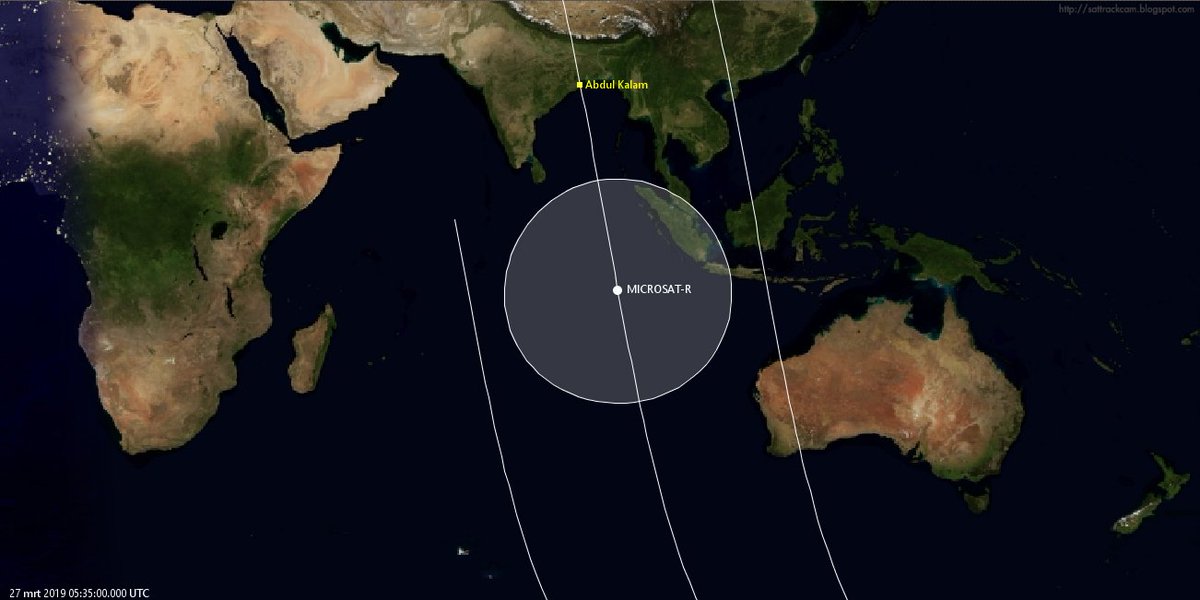Galactic Penguin SST
BANNED

- Joined
- Aug 10, 2017
- Messages
- 1,454
- Reaction score
- 1
- Country
- Location
Unfortunately the launch failed. 2nd stage lost control after separation.

India's 27 March 2019 First ASAT Test V1.1B
First posted 27 March2019; Updated 28 March 2019
Table of Contents
1. Key Data
2. A Strong Unveiled Outer Space Message From Modi To Xi
3. Commentary
4. Conclusion
Key Data
Wed, 27 Mar 2019 09:09:21 +0000
the launch site was Dr. A P J Abdul Kalam Island which ties in with the image posted.
http://satobs.org/seesat/Mar-2019/0132.html
the launch site was Dr. A P J Abdul Kalam Island which ties in with the image posted.
http://satobs.org/seesat/Mar-2019/0132.html

https://pbs.twimg.com/media/D2qSHW2WsAUbcL1.jpg
▲ 1. The launch site was Dr. A P J Abdul Kalam Island
Wed, 27 Mar 2019 07:24:56 -0400
the most likely target of India's #ASAT test was Microsat-r (2019-006A). My analysis shows the test must have happened near 5:40 UT when the sat was moving northwards towards Abdul Kalam:
http://satobs.org/seesat/Mar-2019/0138.html
the most likely target of India's #ASAT test was Microsat-r (2019-006A). My analysis shows the test must have happened near 5:40 UT when the sat was moving northwards towards Abdul Kalam:
http://satobs.org/seesat/Mar-2019/0138.html

https://i.imgur.com/AYMhKBj.jpg
▲ 2. NAVAREA
3:02 AM - 27 Mar 2019
MICROSAT-R, in a 260 x 282 km, 89.9 deg orbit. Would have been ascending over NOTAM area at ~0530 UTC, within the 0430-0830 UTC window. It should have been operational, facilitating tracking.

https://pbs.twimg.com/media/D2qDHCfWwAsimgp.jpg
▲ 3. Target satellite MICROSAT-R on 27 March 2019 at 5:36 UTC
https://twitter.com/TSKelso/status/1110844419333337088
MICROSAT-R, in a 260 x 282 km, 89.9 deg orbit. Would have been ascending over NOTAM area at ~0530 UTC, within the 0430-0830 UTC window. It should have been operational, facilitating tracking.

https://pbs.twimg.com/media/D2qDHCfWwAsimgp.jpg
▲ 3. Target satellite MICROSAT-R on 27 March 2019 at 5:36 UTC
https://twitter.com/TSKelso/status/1110844419333337088
- MICROSAT-R satellite listed with a launch mass of 740 kg. It was just launched on 24 January 2019, as optical remote sensing satellite.
- The Fengyun 1C weather satellite that China destroyed in 2007 was 750 kg.
A Strong Unveiled Outer Space Message From Modi To Xi
By adding the flight path of the Chinese OS-M1 maiden flight with the satellite Lingque-1B from Jiuquan SLC launched just four hours latter, on March 27, 2019 at 09:39 UTC.
With the NAVAREA issued for the experimental flight trial scheduled from 27 March 2019, 4:30 to 8:30 UTC.
It is obvious that the message was intended to President Xi.

And this means that in case of a military conflict, China will no longer be able to easily replace lost satellites with rapid reaction launchers such as previously thought, by using CZ-11 SLV or the new new OS-M1 SLV. Sun Synchronous Orbit (SSO) satellite launches that must overflight the Bay of Bengal would be intercepted before any payload could be delivered into space.
For now, peace is the only viable option for the two Asian Giants, as demonstrated over the last 12 millenia of coexistence.

https://i.imgur.com/7B1duys.jpg ; https://imgur.com/a/02S2WG3
▲ 4. Chinese OS-M1 maiden flight with the satellite Lingque-1B from Jiuquan SLC

https://i.imgur.com/UPJgJkP.jpg ; https://imgur.com/a/02S2WG3
▲ 5. Indian NAVAREA issued for the experimental flight trial scheduled from 27 March 2019, 4:30 to 8:30 UTC

https://i.imgur.com/4ckVPiz.jpg ; https://imgur.com/a/02S2WG3
▲ 6. Indian message intended to President Xi.
Commentary
Statistically, that is over 12'000 years of human recorded demographic history, China has always lead, second to none.
No wonder, as India was always lagging so far behind the Chinese Civilization over the past 12 millenia, and today's final acknowledgement of China as their leader, though belated, shows their awakening.
https://i.imgur.com/z5YzYgm.mp4 ; https://imgur.com/gallery/aOhIuEF ; https://themasites.pbl.nl/tridion/en/themasites/hyde/basicdrivingfactors/population/index-2.html
▲ 7. Population Through the Ages.
12'000 years of Population estimates are from the History Database of the Global Environment (HYDE).
Conclusion
And no surprise either, India always following the steps of China, 12 years latter than China's 2007 first ASAT test, and 6 years latter than the 2013 Chang'e-3 lunar lander and rover!
While we are still waiting for India's first indigenous astronaut, 16 years after Shenzhou-5...






























